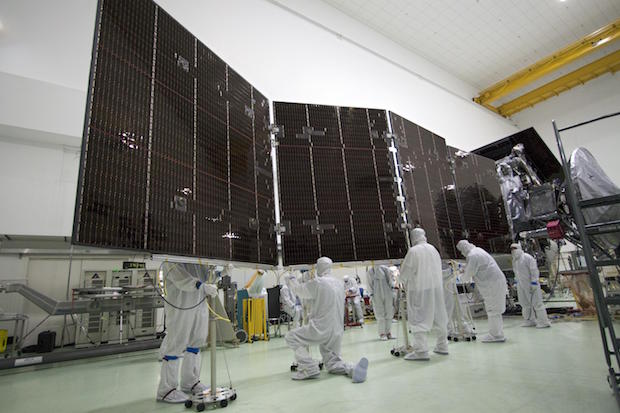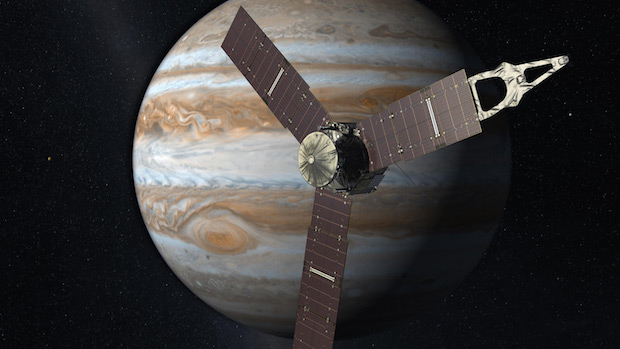
One of Juno’s 3 solar panels. This section will produce about 5kW in earth orbit, and 185W in Jupiter Orbit. Image: NASA/JPL
Juno, the first solar powered space probe to be sent to Jupiter, entered orbit around the gas giant planet yesterday. Its mission is to probe Jupiter in ways it has never been probed before to discover clues about its formation, internal structure, water content, and weather. Part of its mission is the investigate the Great Red Spot. However, because it is currently only around half the size it was 100 years ago, it is now really just an Okay Red Spot.
The solar powered Rosetta space probe, which is currently bothering a comet, almost reached as far as Jupiter’s orbit in 2012. But for the two and a half years it was at the furthest distance from the sun the lazy thing went into hibernation due to a lack of electricity. Juno has broken the record for the greatest distance from the sun that a fully operational solar powered probe has traveled.
All previous probes to Jupiter and beyond used nuclear material to power themselves instead of solar panels because sunlight at Jupiter is only 3.7% as strong as it is in earth orbit. But thanks to the reduced weight and improved efficiency of solar cells it is now cost effective to use solar power instead.
Previous Probes Used Plutonium-238
All previous space probes to Jupiter and beyond used Plutonium-238 in a radioisotope thermoelectric generator. This is a fancy way of saying they used the heat given off by a lump of radioactive isotope to generate electricity.
Plutonium-238 is not cheap, but unfortunately there isn’t really any radioactive material that is more suitable for deep space missions. To power the Juno space probe with it would have required around 18 kilograms of the stuff. At a cost of approximately $11 million per kilogram it would come to about $200 million.
It also has the draw back of being dangerous to people’s health should it happen to be sprinkled over Florida after a launch accident. Sure, having a space probe’s solar panels land on your head is also dangerous for your health, but plutonium-238 is even more dangerous.
Juno’s High Efficiency Multi-Junction Solar Cells
Juno used multi-junction gallium arsenide solar cells produced by the Spectrolab company which makes 60% of all solar cells that are shot into space. Under optimal conditions the cells have an efficiency of 28%. That is 5 percentage points more than the best solar panel you can buy at the moment. Sure, if you really wanted to, you could buy 38.5% efficient multi-junction solar cells from Spectrolab and wire them into a solar panel to make yourself something even better than what the Juno space probe has, but that would probably indicate you are some kind of currency based life-form, because you would have to be made out of money to afford to do that.
The multi-junction cells are able to have much higher efficiencies than even the best solar panels we put on our roofs because they have multiple layers that specialize in converting different wavelengths of light energy into electrical energy. There are people working to bring down their cost, but at the moment the process is too expensive for conventional solar panels.
Juno’s Solar Array

Juno in all it’s solar glory, generating about 500W in Jupiter’s orbit. Image: NASA/JPL
Juno’s 19,000 solar cells are arranged into three panels that fold out to be 2.7 meters wide by 3.9 meters long and the total area covered by cells is apparently 60 square meters. NASA says in earth orbit they will produce around 14 kilowatts, which means they would only operate at about 23% efficiency rather than their maximum of 28%.
They are expected to provide approximately 486 watts in Juno’s current position, orbiting Jupiter, 780 million kilometers from the sun. Around 150+ watts will be used to keep the space probe warm while around 250 watts are required to operate the probe’s instruments. The extra capacity of the solar panels is to compensate for degradation they will suffer from passing through Jupiter’s intense radiation belts multiple times or from any other causes, such as micrometeorite strikes.
The total weight of the solar panels comes to almost 340 kilograms. It could have been slightly less, but they had to make one panel stronger to hang an instrument off it. A radioisotope thermoelectric generator, including 18 or so kilograms of plutonium-238, would have massed around 100 kilograms. Because it is so expensive to shoot stuff into space normally probe makers go with whatever option has the least mass, but plutonium-238 is so expensive it is an exception to this rule.
Future Developments
While Juno’s panels are highly efficient and extremely reliable, they are not cutting edge technology. This is because Jupiter is what we scientists call ‘a very long way away’ and so it took just under 5 years for the probe to get there. In addition, it takes a long time to design and build a probe and NASA, quite sensibly, values proven reliable technology over stuff that is fancy and new. So really, this was cutting edge technology back in 2005. We can do even better now.
Next decade space probes could be launched with solar panels that provide twice as much energy per kilogram as Juno’s and this may be sufficient to send solar powered probes all the way to Saturn where sunlight is only 1.1% as strong as in earth orbit. But that is in the future. For now we’ll just have to wait and see what NASA and other space programs can achieve.

 RSS - Posts
RSS - Posts



Speak Your Mind